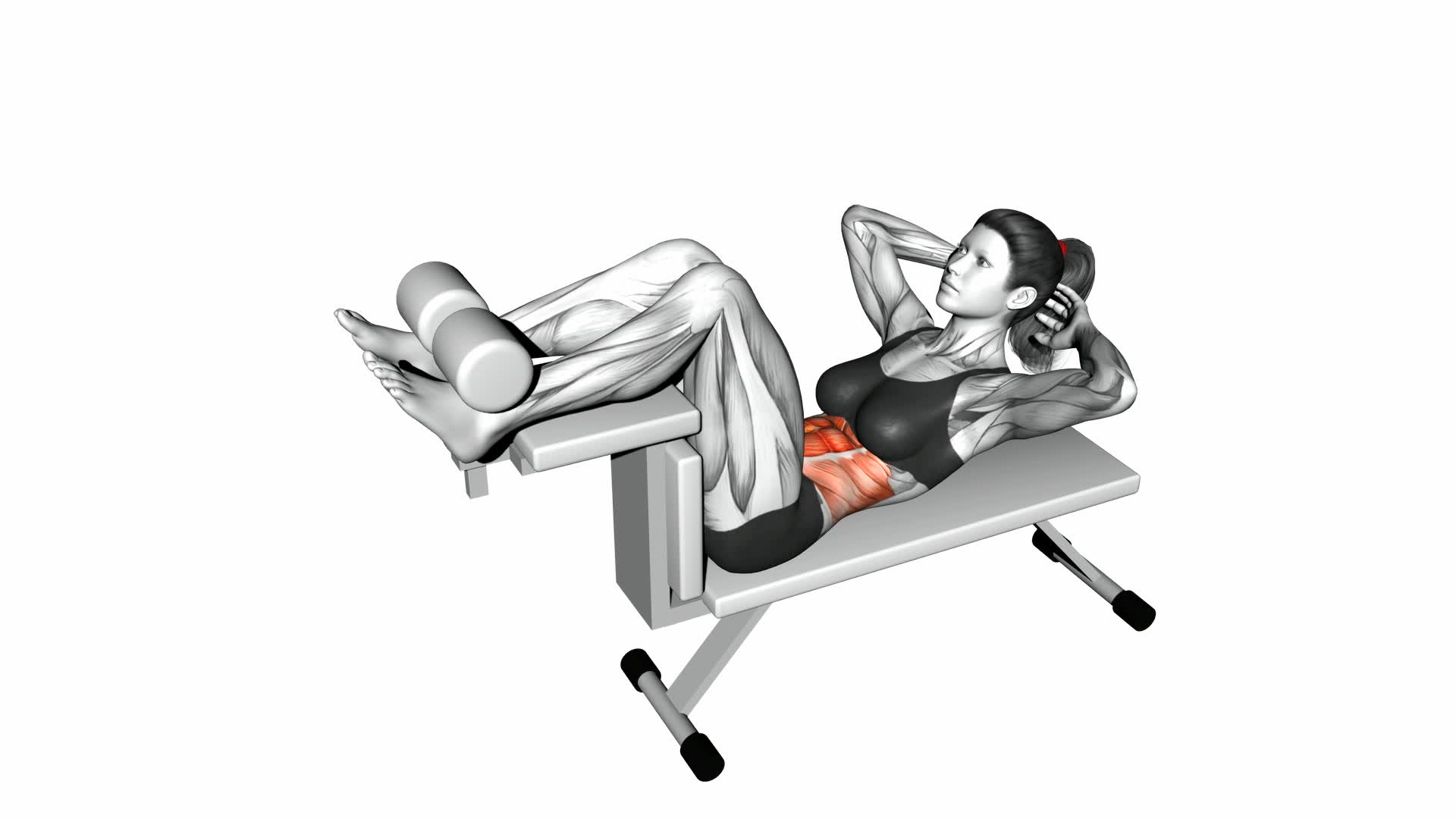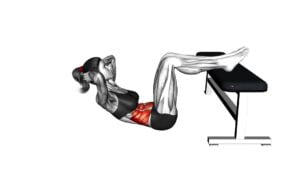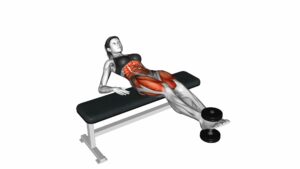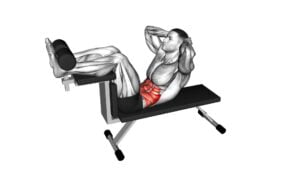Crunch (On Bench) – Video Exercise Guide & Tips

Are you looking to strengthen your core and sculpt those abs? Look no further than the crunch (on bench) exercise.
Watch This Exercise Video
This video exercise guide will show you the proper form and technique to maximize your results. You'll also discover the benefits of this exercise, common mistakes to avoid, and modifications to challenge yourself.
Get ready to feel the burn and achieve your fitness goals with this effective workout move. Let's get started!
Key Takeaways
- Proper form and technique is essential for the crunch exercise on the bench, including positioning, controlled movements, and proper breathing techniques.
- The crunch exercise targets abdominal muscles, increases core strength, and improves posture and stability.
- Common mistakes to avoid include using the neck instead of engaging the abdominal muscles, lifting the entire back off the bench, and rushing through the movement with momentum.
- Modifications and progressions can be made by adjusting the incline of the bench, using unstable surfaces, adding weight, incorporating twists, and gradually increasing difficulty while maintaining proper form.
Proper Form and Technique
To perform the crunch (on bench) exercise with proper form and technique, position yourself on the bench with your feet planted firmly on the ground. One of the common misconceptions about crunches is that you need to lift your entire upper body off the bench. However, this isn't true. When doing a crunch, you only need to lift your shoulders off the bench, while keeping your lower back pressed against it. This ensures that you're targeting your abdominal muscles effectively without straining your neck or lower back.
Another important aspect of proper form is maintaining a controlled and steady pace throughout the exercise. Avoid using momentum or jerky movements, as this can reduce the effectiveness of the exercise and increase the risk of injury. Remember to exhale as you lift your shoulders off the bench and inhale as you lower them back down. Incorporating proper breathing techniques helps engage your core muscles and provides stability during the movement.
Benefits of the Crunch (On Bench) Exercise
When performing the crunch (on bench) exercise, you can experience a range of benefits that contribute to strengthening your core and improving overall abdominal muscle definition. The crunch (on bench) exercise specifically targets your abdominal muscles, helping to tone and sculpt them. By engaging your core muscles during the exercise, you can increase your core strength, which is essential for maintaining proper posture and stability in daily activities and sports.
One of the main benefits of the crunch (on bench) exercise is that it effectively targets your rectus abdominis, the muscle responsible for the coveted six-pack appearance. By consistently incorporating this exercise into your fitness routine, you can develop defined and sculpted abs.
Additionally, the crunch (on bench) exercise also works your oblique muscles, which are located on the sides of your waist. Strengthening these muscles can help improve your overall core stability and enhance your performance in activities that require twisting or rotating movements, such as golf or tennis.
Incorporating the crunch (on bench) exercise into your workout routine can also help improve your posture by strengthening your core muscles. A strong core provides stability and support for your spine, reducing the risk of lower back pain and injuries.
Common Mistakes to Avoid
Make sure you steer clear of these common mistakes when performing the crunch (on bench) exercise. Proper technique is essential to maximize the effectiveness of this exercise and prevent injury. One common mistake is using the neck to initiate the movement instead of engaging the abdominal muscles. To avoid this, keep your chin lifted slightly and focus on pulling your belly button towards your spine.
Another mistake is lifting the entire back off the bench, which puts excessive strain on the neck and lower back. Instead, focus on lifting only the shoulder blades off the bench while keeping the lower back in contact with it.
It's also important to avoid pulling on the head or neck with your hands, as this can strain the neck and reduce the effectiveness of the exercise. Lastly, rushing through the movement and using momentum instead of controlled muscle contractions is a common mistake. Remember to perform the crunch slowly and intentionally, focusing on squeezing the abdominal muscles at the top of the movement.
By avoiding these common mistakes and maintaining proper technique, you can maximize the benefits of the crunch (on bench) exercise.
Now that you understand the common mistakes to avoid, let's move on to discussing modifications and progressions for the crunch (on bench) exercise.
Modifications and Progressions
Now let's explore some ways you can modify and progress the crunch (on bench) exercise to challenge your abdominal muscles even further.
To modify the crunch (on bench) exercise, you can start by adjusting the incline of the bench. Increasing the incline will make the exercise more challenging, as it increases the resistance placed on your abdominal muscles.
You can also try performing the crunch on an unstable surface, such as a stability ball or a Bosu ball. This will engage your core muscles even more as they work to stabilize your body during the exercise.
To progress the crunch (on bench) exercise, you can add weight to increase the resistance. Holding a dumbbell or a weighted plate against your chest will make the exercise more demanding for your abdominal muscles.
Another way to progress the exercise is by incorporating a twist. While performing the crunch, twist your torso to one side, engaging your oblique muscles. Alternate the twist on each repetition to work both sides of your midsection.
Remember to always maintain proper form and control throughout the exercise. Start with modifications that challenge you but still allow you to perform the exercise with good technique.
As you get stronger, gradually progress by increasing the difficulty level. By incorporating these modifications and progressions, you can continue to challenge and strengthen your abdominal muscles.
Tips for Maximizing Results
To maximize your results during crunches on a bench, it's important to focus on efficient workout techniques.
This includes maintaining proper form, engaging your core muscles fully, and controlling the movement throughout each repetition.
Additionally, setting specific goals and tracking your progress can help you stay motivated and ensure that you're continuously challenging yourself.
Efficient Workout Techniques
Get the most out of your workouts by incorporating efficient techniques that maximize your results. Here are four tips to help you achieve your fitness goals:
- Prioritize compound exercises: Instead of isolating specific muscles, focus on exercises that engage multiple muscle groups simultaneously. This not only saves time but also enhances overall strength and coordination.
- Incorporate HIIT (High-Intensity Interval Training): HIIT involves short bursts of intense exercise followed by brief recovery periods. This type of training is highly efficient, boosting calorie burn and improving cardiovascular fitness in a shorter amount of time.
- Optimize rest intervals: While it's important to push yourself during workouts, allowing adequate rest between sets is crucial for muscle recovery and growth. Aim for 30-60 seconds of rest between exercises to maintain intensity without sacrificing quality.
- Incorporate supersets or circuit training: By performing exercises back to back with minimal rest, you can maximize your workout time and increase calorie burn. This method also keeps your heart rate elevated, providing cardiovascular benefits along with strength training.
By implementing these efficient workout techniques, you can make the most of your exercise routine and move closer to achieving your fitness goals.
Now, let's dive into goal-setting strategies to further enhance your progress.
Goal-Setting Strategies
To maximize your results, incorporate goal-setting strategies that align with your fitness objectives. Setting clear and specific goals is essential for staying motivated and tracking your progress.
Start by identifying what you want to achieve, whether it's losing weight, building muscle, or improving overall fitness. Break down your larger goals into smaller, achievable milestones to keep yourself motivated along the way.
It's also important to set a timeline for reaching each milestone to stay focused and accountable. Additionally, make your goals measurable by including specific numbers or metrics. For example, aim to increase your bench press weight by 10 pounds within three months.
Sample Workout Routine Incorporating the Crunch (On Bench) Exercise
Now that you understand the proper form for the crunch (on bench) exercise, let's discuss how to incorporate it into a sample workout routine.
There are a few key points to keep in mind.
First, if you're a beginner, start with the basic variation of the crunch (on bench) and focus on perfecting your form.
As you become more advanced, you can add resistance by holding a weight plate or dumbbell to challenge your core muscles even more.
Proper Form Tips
Ensure proper form during the Crunch (On Bench) exercise by keeping your back straight and engaging your core muscles. To maximize the benefits of this exercise, follow these tips:
- Core engagement: Before starting the crunch, activate your core muscles by pulling your belly button towards your spine. This will help stabilize your torso and prevent strain on your lower back.
- Breathing technique: Exhale as you lift your upper body off the bench, contracting your abdominal muscles. Inhale as you lower back down.
- Maintain a neutral neck position: Avoid straining your neck by keeping it aligned with your spine throughout the movement. Place your hands gently behind your head, without pulling on your neck.
- Control your movements: Avoid using momentum to perform the crunch. Instead, focus on slow and controlled movements, ensuring that your abs do the work.
Variations for Beginners
To incorporate the Crunch (On Bench) exercise into a beginner's workout routine, there are several variations that can be implemented. These variations are beginner-friendly modifications that can help you gradually build strength and improve your form.
One variation is the Reverse Crunch (On Bench), where you lie on the bench with your legs in the air and bring your knees towards your chest, engaging your core muscles.
Another variation is the Bicycle Crunch (On Bench), where you lie on the bench and perform a bicycle motion with your legs while simultaneously twisting your upper body to touch your elbow to the opposite knee.
These variations target different areas of your abs and can help prevent common errors in form for beginners, such as straining the neck or using momentum to lift the upper body.
Incorporating these variations into your workout routine will provide a well-rounded abdominal workout while ensuring proper form and preventing injuries.
Adding Resistance for Advanced
To make the Crunch (On Bench) exercise more challenging for advanced individuals, incorporate resistance by holding a weighted plate against your chest during the movement. This will engage your abdominal muscles even more and help you strengthen your core.
Here are four advanced modifications and resistance techniques you can try:
- Increase the weight: Gradually increase the weight of the plate to continually challenge your muscles and stimulate growth.
- Use a resistance band: Attach a resistance band to the bench and loop it around your shoulders, creating additional tension as you perform the crunch.
- Try a medicine ball: Hold a medicine ball against your chest instead of a weighted plate, adding an unstable element to the exercise and engaging more muscles.
- Perform a decline bench crunch: Adjust the bench to a decline position and perform the crunch with the weighted plate for added resistance and intensity.
Incorporating these advanced modifications and resistance techniques will take your Crunch (On Bench) exercise to the next level and help you achieve your fitness goals.
Frequently Asked Questions
How Many Sets and Repetitions Should I Perform for the Crunch (On Bench) Exercise?
To progress in the crunch (on bench) exercise, it's important to find the right balance of sets and repetitions. Start with 3 sets of 10-12 repetitions and gradually increase the intensity as you get stronger.
Avoid common mistakes like pulling on your neck or using momentum to lift your upper body. Focus on engaging your core and using controlled movements for maximum effectiveness.
Can I Do the Crunch (On Bench) Exercise if I Have Lower Back Pain?
If you have lower back pain, it's important to avoid exercises that may aggravate it. The crunch (on bench) exercise can put strain on the lower back, so it may not be the best choice for you.
However, there are alternative exercises that can target your abdominal muscles without putting stress on your back. Remember to always maintain proper form and technique to prevent injury and consult with a healthcare professional if you have any concerns.
Is It Necessary to Use a Bench for the Crunch Exercise, or Can I Perform It on the Floor?
Using a bench for the crunch exercise provides several benefits. It allows for a greater range of motion, targeting your abs more effectively. The bench also provides stability and support for your back, reducing the risk of injury.
However, it isn't necessary to use a bench for the crunch exercise. You can perform it on the floor if you prefer. Just make sure to maintain proper form and engage your core muscles throughout the movement.
What Muscles Does the Crunch (On Bench) Exercise Primarily Target?
The crunch (on bench) exercise primarily targets your core muscles, including the rectus abdominis and obliques. It's a great way to strengthen and tone your midsection. By using a bench, you can increase the range of motion and engage your muscles more effectively.
If you're a beginner, you can modify the exercise by using a lower incline or starting with smaller movements. Incorporating the crunch (on bench) into your routine can provide numerous benefits for your core strength.
Are There Any Alternative Exercises That Can Provide Similar Benefits to the Crunch (On Bench) Exercise?
If you're looking for alternative exercises that can provide similar benefits to the crunch exercise on a bench, there are a few options you can try.
Plank variations, such as the forearm plank or side plank, engage your core muscles and can help strengthen your abs.
Another option is the Russian twist, which targets your obliques.
Both of these exercises can help improve your core strength and stability, just like the crunch on a bench.
Conclusion
In conclusion, the Crunch (On Bench) exercise is an effective way to strengthen your abdominal muscles. By performing this exercise with proper form and technique, you can reap the benefits of improved core stability and posture.
It's important to avoid common mistakes and make modifications as needed to avoid injury and maximize results. Incorporating the Crunch (On Bench) exercise into your workout routine can help you achieve a stronger and more defined midsection.

Author
Years ago, the spark of my life’s passion ignited in my mind the moment I stepped into the local gym for the first time. The inaugural bead of perspiration, the initial endeavor, the very first surge of endorphins, and a sense of pride that washed over me post-workout marked the beginning of my deep-seated interest in strength sports, fitness, and sports nutrition. This very curiosity blossomed rapidly into a profound fascination, propelling me to earn a Master’s degree in Physical Education from the Academy of Physical Education in Krakow, followed by a Sports Manager diploma from the Jagiellonian University. My journey of growth led me to gain more specialized qualifications, such as being a certified personal trainer with a focus on sports dietetics, a lifeguard, and an instructor for wellness and corrective gymnastics. Theoretical knowledge paired seamlessly with practical experience, reinforcing my belief that the transformation of individuals under my guidance was also a reflection of my personal growth. This belief holds true even today. Each day, I strive to push the boundaries and explore new realms. These realms gently elevate me to greater heights. The unique combination of passion for my field and the continuous quest for growth fuels my drive to break new ground.



